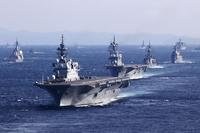It's not easy building a laser weapon. And the hardest part might be keeping the ray gun cool. Take the Airborne laser, for example. The blaster-carrying, modified 747 scheduled for test flights later this decade has a powerful chemical laser cannon that heats up to 540 degrees celsius when fired. Each few-second blast needs to be followed by minutes of cool-down time. 8,000 gallons of hydrogen peroxide and other chemicals has to be flushed out and chilled to prepare for the next blast.
Take the Airborne laser, for example. The blaster-carrying, modified 747 scheduled for test flights later this decade has a powerful chemical laser cannon that heats up to 540 degrees celsius when fired. Each few-second blast needs to be followed by minutes of cool-down time. 8,000 gallons of hydrogen peroxide and other chemicals has to be flushed out and chilled to prepare for the next blast.
Next-generation, solid state lasers aren't much easier to handle. True, there are no chemical vats. But the gases, liquids, and mists required to keep these ray guns cool are plenty bulky. And they, too, need to be swept out before the laser can fire again. It's one of many reasons why lasers are being planned for big, clunky planes like the 747 and not for fighter jets.
For years, Darpa, the Pentagon's way-out research arm, has been bankrolling a project to cool a high-energy laser with a liquid that has the same angle of refraction as the mirrors inside the blaster. That way, the ray gun can fire away, even while it's being cooled. The weapon should take up a whole lot less room. And that could pave the way to putting a blaster "on a ground vehicle, a helicopter, a jet," according to Charles Manor, a spokesman for Lockheed Martin, which was recently named the weapon system integrator for this High Energy Liquid Laser Area Defense System (HELLADS) project.
The San Francisco Chronicle notes that General Atomics maker of the Predator drone will build HELLADS' laser, "while Lockheed will develop the system's ability to pinpoint and track a target."
The goal is to have, by 2009, a powerful blaster that's be "an order of magnitude" lighter than comparable lasers five kilograms for every kilowatt of energy produced.
The HELLADS project is "currently in the third of five phases," General Atomics says.
The current phase consists of developing the technology necessary to demonstrate a subscale [15 kw] prototype laser system in the laboratory. This subscale demonstrator shall be constructed in the same geometry and operate with a fluence comparable to that of the final weapon system.
As currently envisioned, the fourth phase shall consist of a ground-based laser weapon system demonstrator with an approximate average power of 150 kW. The laser weapon system demonstrator constructed in this phase shall employ a design and materials which demonstrate the ability of the final weapon to achieve low specific weight (5 kg/kW) and a compact geometry suitable for deployment on tactical systems [like a Humvee or a fighter plane].
The final phase consists of the engineering, fabrication, integration and demonstration of a complete HELLADS weapon system on a tactical platform.
 That platform might even be robotic, Darpa chief Tony Tether told Congress back in 2003.
That platform might even be robotic, Darpa chief Tony Tether told Congress back in 2003.With HELLADS, the next-generation Predator B or the heavily-armed Unmanned Combat Aerial Vehicle "could protect fixed installations or population centers from attack, patrol a border, or patrol a demilitarized zone with the capability to react to hostile actions and engage tactical missiles, rockets, or artillery at the speed of light." Darpa wants to spend $60 million over the next three years on the system.







